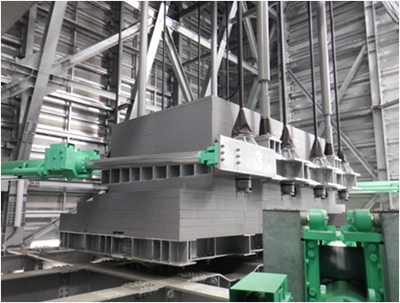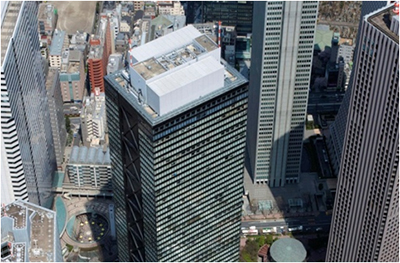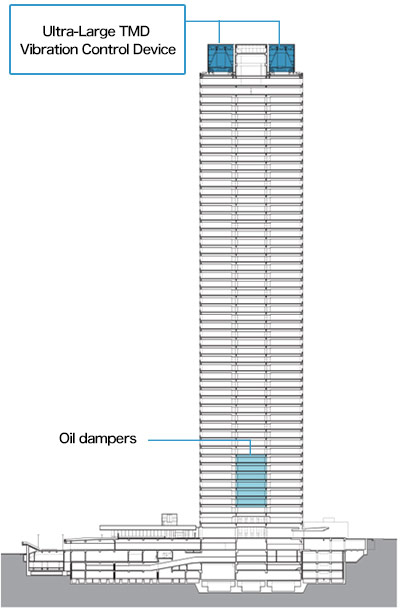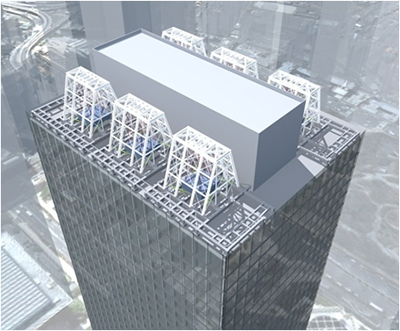Halving Shaking Due to Long-Period Earthquake Ground Motion at Shinjuku Mitsui Building
Japan’s First Rooftop-Installed Ultra-Large Vibration Control Device (Approx. 1,800 tons) Completed
May 14, 2015
Mitsui Fudosan Co., Ltd.
Kajima Corporation
Mitsui Fudosan Co., Ltd. has been involved in and completed the installation on April 30 of Japan's first tuned mass damper (TMD) ultra-large vibration control device (approx. 1,800 tons) on the roof of the Shinjuku Mitsui Building to dramatically reduce shaking caused by long-period earthquake ground motion. The Shinjuku Mitsui Building is now equipped to substantially reduce the amplitude and duration of shaking caused by long-period ground motion.
The Shinjuku area where the building is located was subject to substantial long-period ground motion in the Great East Japan Earthquake. Kajima Corporation began installing the device from mid-August 2013, aiming to ease the concerns of office workers by keeping the magnitude of building motion within the range of the most state-of-the-art skyscraper.
This ultra-large TMD vibration control device represents the further development and application of the pendulum-mass system that is conventionally used to control the wind-induced motion of skyscrapers. In this undertaking, Mitsui Fudosan and Kajima have developed and applied this technology for the first time in Japan to commercialize a vibration control device to control the seismic shaking of a skyscraper caused by earthquakes.
The Shinjuku Mitsui Building is a structurally rated, Ministerial-approved building that provides a high level of safety, and its seismic performance was fully adequate even before installation of the device. However, due to increased concern among tenants about safety and security since the Great East Japan Earthquake, and in response to demand for business continuity planning (BCP) initiatives, Mitsui Fudosan has been taking additional system- and facility-related measures that include renovations to upgrade the disaster prevention and BCP-related functions of existing buildings, including the Shinjuku Mitsui Building, to a level equivalent to a new building. Installation of the TMD device on this existing building brings it up to the level of a new building in terms of long-period ground motion measures and further reinforces the above-mentioned safety initiatives.
Under the slogan “Next - Generation Offices, ” Mitsui Fudosan will continue to provide distinctive office buildings that go beyond conventional concepts to generate new added value, beginning with this TMD project to provide high-level continuity and fully realized peace of mind to the building's occupants and workers, their families, tenant companies and the local community.
Kajima Corporation is one of Japan's pioneering companies in skyscraper construction and an industry leader in seismic control structures in particular, having developed related technologies since the 1980's and created the world's first building with integrated seismic control. Technology referred to here is an effective solution for eliminating concerns associated with the substantial shaking that can occur in most existing high-rise buildings due to long-period ground motion during earthquakes. Kajima Corporation intends to utilize the technology to help provide living environments that are safe, comfortable and secure.
* TMD: A device designed to control vibrations by attaching a mass to a building via a damper, and optimally tuning the natural frequency of the system.

Photo of the completed TMD

Aerial view of the Shinjuku Mitsui Building

Schematic diagram of Shinjuku

Ultra-Large TMD Vibration Control Device (conceptual diagram with outer wall cover removed)